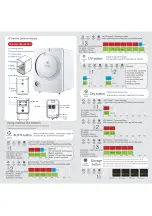
TROUBLE SHOOTING GUIDE FOR UNITS WITH DX COOLING
13
2.
Restricted Filter-Drier
- The liquid line filter-drier may become clogged with dirt and other foreign matter left in
the system during erection. This will most likely occur during the first few weeks of system operation. A
temperature drop between the inlet and outlet connections evidences a clogged filter-drier. If it is badly clogged,
frost may appear on the outlet piping. The restriction is causing a pressure drop, which, in turn, is causing the liquid
to flash. Flash gas reduces the capacity of the expansion valve, resulting in a reduction in evaporator capacity and
suction pressure.
3.
Leaking Liquid Line Solenoid Valve
- If the liquid line solenoid valve leaks badly, the compressor may be
unable to reduce the suction pressure sufficiently to terminate the pump-down cycle. This will cause the compressor
to run continuously on its minimum stage of loading. A temperature drop evidences a leaking valve across the valve
body and the appearance of flash gas in the liquid line sight glass.
4.
Broken Compressor Valves
- Broken compressor valves are generally indicated by a rapid rise in suction
pressure immediately after the machine is stopped. If the suction pressure rises faster than 4 psig per minute, the
compressor valves are not holding. However, before any action is taken, make certain that the pressure rise is not
caused by a pressure leak on the low side of the system, such as a leaking liquid line solenoid valve.
5.
Superheat Adjustment
- If the thermostatic expansion valve is adjusted to produce too little superheat, liquid
refrigerant may pass from the evaporator into the suction line. An abnormally cold suction line and possible liquid
flood-back to the compressor evidence this. On the other hand, too much superheat results in the feeding of too little
refrigerant to the evaporator. This will cause a shortage of evaporator capacity, which is particularly noticeable at
system full load conditions. Adjust the superheat carefully, taking as accurate suction pressure and temperature
readings as possible. Normally, 12 to 15 F of superheat are satisfactory for most air conditioning applications.
6.
Inoperative Expansion Valve
- If an expansion valve is protected from dirt and other foreign matter by a liquid
line filter-drier, the most likely cause for malfunction is loss of charge from the valve power element. When this
occurs, the valve remains closed or nearly closed. An inoperative expansion valve is indicated by low evaporator
capacity, low suction pressure, high superheat and frosting at the evaporator inlet. To test for an inoperative power
element:
a. Stop
compressor.
b.
Remove remote bulb from suction line.
c.
Place bulb in container of ice water.
d. Start
compressor.
e.
Remove bulb from ice water and warm in hand. At the same time check the temperature of the
suction line at the evaporator. If a rapid reduction in temperature is noted, the element is working
properly.
Warning, Do not allow liquid to flood-through the coil for any longer than is necessary to complete the test. Flood-
back to the compressor should be avoided at all cost.










































